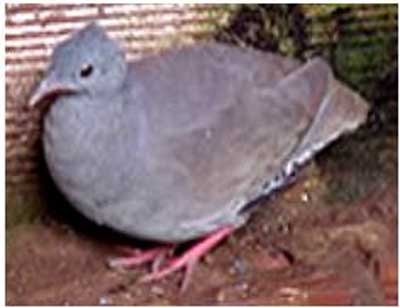Crypturellus parvirostris (*) Cladus: Eukaryota Name Crypturellus parvirostris (Wagler, 1827) References * Systema Avium Crypturus p.[295] Citation Vernacular names The Small-billed Tinamou Crypturellus parvirostris is a type of Tinamou commonly found in dry savanna in Amazonian South America.[3] Description The Small-billed Tinamou is approximately 22 cm (8.7 in) in length. Its upperparts are dark brown, with grey to brownish under parts and head. Its bill and legs are red. Taxonomy All tinamou are from the family Tinamidae, and in the larger scheme are also Ratites. Unlike other Ratites, Tinamous can fly, although in general, they are not strong fliers. All ratites evolved from prehistoric flying birds, and Tinamous are the closest living relative of these birds.[4] Etymology Crypturellus is formed from three Latin or Greek words. kruptos meaning covered or hidden, oura meaning tail, and ellus meaning diminutive. Therefore Crypturellus means small hidden tail.[5] Behavior Like other Tinamous, the Small-Billed eats fruit off the ground or low-lying bushes. They also eat small amounts of invertebrates, flower buds, tender leaves, seeds, and roots. The male incubates the eggs which may come from as many as 4 different females, and then will raise them until they are ready to be on their own, usually 2–3 weeks. The nest is located on the ground in dense brush or between raised root buttresses.[4] Range and habitat The Small-billed Tinamou prefers dry savanna, but will also reside in lowland shrubland.[6] Its range is Amazonian South America; Brazil except for the southeastern portion, northeastern Peru, eastern Bolivia, Paraguay, and northeastern Argentina.[3][6] Conservation The IUCN classifies this Tinamou as Least Concern,[1] with an occurrence range of 6,700,000 km2 (2,590,000 sq mi).[6] Footnotes 1. ^ a b BirdLife International (2008)
* BirdLife International (2008). Crypturellus parvirostris. 2006. IUCN Red List of Threatened Species. IUCN 2006. www.iucnredlist.org. Retrieved on 09 Feb 2009. Source: Wikipedia, Wikispecies: All text is available under the terms of the GNU Free Documentation License |
|

